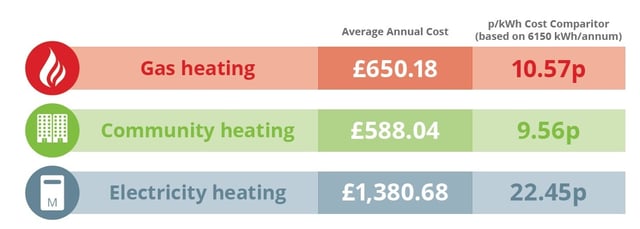It goes without saying that residents want a reliable heating system that will heat their home whenever they need it and for the right price. After all, 60 per cent of a household's yearly energy bills is heating.
Yet what exactly is the right price? People usually think about gas when comparing energy prices, but the comparison isn't always straightforward.
Communal heating systems can be a cost-effective and energy-efficient way of heating homes.

The above data was captured from residents' on a Switch2 community heating scheme in 2014 and compared with costs discussed in the Which? Report: Turning up the heat.
As shown on the comparison chart above, a resident's average annual cost for gas heating is £650.18, while the cost of electricity heating is a staggering £1,380.68. However, the average annual cost of community heating is significantly less than either gas or electricity, averaging at just £588.04 per year. This demonstrates just how much residents could save every year if they were part of a metered communal heating system.
Comparing gas to communal heat
It's important to remember that gas is gas and not heat. With a gas heating system, residents are buying the raw fuel which then needs to be converted into heat via their private boiler.
However, with a district heating scheme, residents buy useful energy at their meter. So you will generally find that per kWh of “useful” heat charged on the community heating system it is significantly more than a kWh of gas, say 6p per kWh as opposed to gas at say 3p per kWh.
Other considerations...
The conversion of gas to heat takes place at a central boiler on community heating, which is generally much more efficient than lots of small individual boiler; but the heat has to be distributed and this adds back some cost.
What about the maintenance costs?
The charge for community heating includes the maintenance of the boiler, where as the gas price does not. Also, the maintenance of individual gas boilers can be quite expensive for landlords who have to ensure they comply with the gas safety check regulations.
Therefore when comparing community heating costs with that of gas or electricity, all of the annual costs of running the heating system should be considered; that way you are comparing apples with apples!
A good discussion of how to compare community heating to other forms of heating can be found in the Which! Report “Turning up the heat: Getting a fair deal for District Heating users”.
Community heating has other advantages that residents should be aware of...
Community heat can also benefit from heat generated from waste or byproducts from industry or by other means are supplied to residents' homes via a network of insulated pipes. Making use of waste energy therefore makes for an overall more efficient and low carbon solution as opposed to using more energy to generate heat, helping to reduce the amount of greenhouse gases that are being released into the atmosphere. This means that residents on community heating system are playing a significant part in helping reduce pollution and CO2 emissions..
Controlling residents' costs
In order to control their energy use, residents need access to information relating to how much energy they are consuming and how much they are spending. Pay-as-you-go systems such as Switch2's G6 are the ultimate solution to these issues, putting the customer first. They are a transparent way of telling the residents how much they use, and enable the residents to engage with their energy consumption.
Using pay-as-you-go apps such as Switch2's Quickpay, residents who are part of a communal heating system can top-up credit to their prepayment unit quickly and easily using web-enabled devices such as smartphones and tablets.
Takeaways:
- Communal heating systems can be more cost-effective than traditional gas and electric systems
- Residents need to understand how to compare their heating cost to those of gas and electricity alternative
- Comparison should be on annual costs not the kWh price. If residents understand the green nature of community heating it will help them understand



